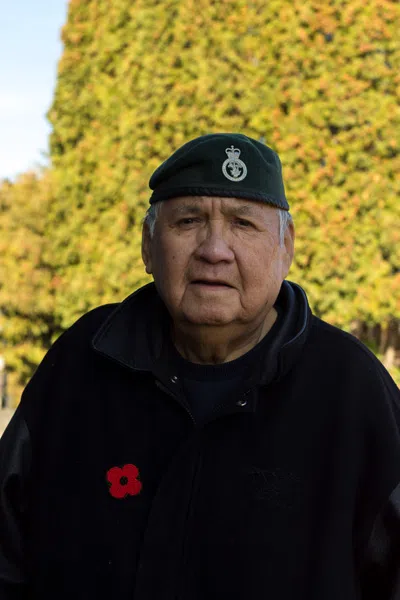
Humans of Saskatoon: Ray Sanderson
Moe
Morin is a freelance writer and photographer and the co-founder of Humans of
Saskatoon. She photographs and interviews people and run their stories on her
highly popular Facebook page. This month she talked to Cold War veteran Ray
Sanderson about his experiences. Below are his unedited words.
My
name is Ray Sanderson, and I’m from James Smith First Nation. At a very young
age I went to residential school like so many of our people, and I suffered in
there. I remember the loneliness, being lonesome for home. I suffered like this
all of my life, and even while in the army, I was lonesome and couldn’t ever
figure it out. I spent 12 years at residential school, and this is how it
affected me.
At
17 years of age I joined the Canadian Army, joining a regiment called The Black
Watch of Canada. Right after basic training, I went overseas to Germany. One
experience I’d like to mention was being an honour guard on the 20th
Anniversary commemorating a battle that took place in Dieppe, France. The
Dieppe Raid was a famous, ill-fated attack on a small French town that was
controlled by the Germans, and the Canadian Army went in there thinking they
might catch them off-guard. Somehow they found out, and many Canadian’s were
killed in action, wounded and taken prisoner. On the 20th Anniversary, I was
part of these ceremonies, and the French people thanked us.
As
I walked around, touring the cliffs where the bunkers were, I could see how
they out manoeuvred the Canadian army. They slaughtered them. Those experiences
that occurred during that raid against the Germans, valuable lessons were
learned and were put to use in June 1944 to be successful on D-Day.
Going
back to early army years, I eventually came back from Germany and transferred
to PPCLI. Again, I was shipped to Germany. Another experience, in West Germany
was in 1966. They were commemorating the 50th Anniversary of Battle of the
Somme, and I went as an honour guard. It was a major battle in France during
the first World War. Again, so many war graves.
One
of the regiments that fought that battle was the Newfoundland regiment, that
one morning when they went over the top to go into battle (when they come out
of the trenches, walking towards the enemy they call it “going over the
top”). 700 men went over the top, walking towards the Germans and again,
they were slaughtered. The next morning, at roll call, some 67 or so men
answered from the 700. These were very young men from Newfoundland, and most of
them 16, 17 or 18 year olds. Two graves were of 15 year old men. Can you
imagine? They made the ultimate sacrifice for their country and gave up their
lives. Absolutely amazing.
What
I found interesting about this experience, was that my Grandfather fought in
the Battle of the Somme, his name was Patrick Brittian. He survived the war,
came home, and was very quiet. We used to ask him, “what is war?” and
he would say, “It’s something dirty, and I don’t want to talk about
something so dirty.” On his return home from WW1, he walked to see the
Indian Agent, and asked about his benefits. They told him, “don’t worry
about it, you don’t qualify anyway.” I know I spoke to you about my Uncle
Roddy Sanderson earlier, he fought in WW2, and after his return home at some
point he found himself in Melfort, SK., on a cold winter night in 1955. He
thought he would walk to the legion, and ask for something warm to drink until
he could find a ride home. He was turned away, and was told Indians weren’t
allowed in the legion. They said, “Go home Indian, you don’t belong
here.”
My
uncle drank a lot, and we didn’t know he suffered from PTSD. I looked after him
for a time, and during the nights, he would scream in the dark from bad dreams.
One night, he was killed while walking in a winter storm. How could they treat
him like that?
Being
in the army taught me discipline, how to look after myself, and be careful in
how you treat people. I’ve learned through War, Elder’s, and going back to my
culture, that whatever you do to someone will always come back to you.
I believe it is
important to also teach school children what First Nation’s veterans have
contributed to our country, those of us that went to war. Some didn’t come
back, and they gave up their lives for this country. The people of Canada have
to know we contributed a lot to this country; we went over and were prepared to
give up our lives so that we could all enjoy this peace today.
Related story:

